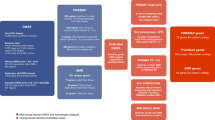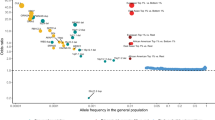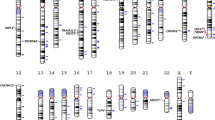Abstract
It is widely thought that alleles that influence susceptibility to common diseases, including schizophrenia, will frequently do so through effects on gene expression. As only a small proportion of the genetic variance for schizophrenia has been attributed to specific loci, this remains an unproven hypothesis. The International Schizophrenia Consortium (ISC) recently reported a substantial polygenic contribution to that disorder, and that schizophrenia risk alleles are enriched among single-nucleotide polymorphisms (SNPs) selected for marginal evidence for association (P<0.5) from genome-wide association studies (GWAS). It follows that if schizophrenia susceptibility alleles are enriched for those that affect gene expression, those marginally associated SNPs, which are also expression quantitative trait loci (eQTLs), should carry more true association signals compared with SNPs that are not marginally associated. To test this, we identified marginally associated (P<0.5) SNPs from two of the largest available schizophrenia GWAS data sets. We assigned eQTL status to those SNPs based upon an eQTL data set derived from adult human brain. Using the polygenic score method of analysis reported by the ISC, we observed and replicated the observation that higher probability cis-eQTLs predicted schizophrenia better than those with a lower probability for being a cis-eQTL. Our data support the hypothesis that alleles conferring risk of schizophrenia are enriched among those that affect gene expression. Moreover, our data show that notwithstanding the likely developmental origin of schizophrenia, studies of adult brain tissue can, in principle, allow relevant susceptibility eQTLs to be identified.
This is a preview of subscription content, access via your institution
Access options
Subscribe to this journal
Receive 12 print issues and online access
$259.00 per year
only $21.58 per issue
Buy this article
- Purchase on Springer Link
- Instant access to full article PDF
Prices may be subject to local taxes which are calculated during checkout
Similar content being viewed by others
References
Cantor RM, Lange K, Sinsheimer JS . Prioritizing GWAS results: A review of statistical methods and recommendations for their application. Am J Hum Genet 2010; 86: 6–22.
Peltonen L, McKusick VA . Genomics and medicine. Dissecting human disease in the postgenomic era. Science 2001; 291: 1224–1229.
Bray NJ, Buckland PR, Owen MJ, O’Donovan MC . Cis-acting variation in the expression of a high proportion of genes in human brain. Hum Genet 2003; 113: 149–153.
Lander ES . The new genomics: global views of biology. Science 1996; 274: 536–539.
Manolio TA, Collins FS, Cox NJ, Goldstein DB, Hindorff LA, Hunter DJ et al. Finding the missing heritability of complex diseases. Nature 2009; 461: 747–753.
Maher B . Personal genomes: The case of the missing heritability. Nature 2008; 456: 18–21.
Purcell SM, Wray NR, Stone JL, Visscher PM, O’Donovan MC, Sullivan PF et al. Common polygenic variation contributes to risk of schizophrenia and bipolar disorder. Nature 2009; 460: 748–752.
Stefansson H, Ophoff RA, Steinberg S, Andreassen OA, Cichon S, Rujescu D et al. Common variants conferring risk of schizophrenia. Nature 2009; 460: 744–747.
O’Donovan MC, Craddock NJ, Owen MJ . Genetics of psychosis; insights from views across the genome. Hum Genet 2009; 126: 3–12.
Shi J, Levinson DF, Duan J, Sanders AR, Zheng Y, Pe’er I et al. Common variants on chromosome 6p22.1 are associated with schizophrenia. Nature 2009; 460: 753–757.
Le-Niculescu H, Balaraman Y, Patel S, Tan J, Sidhu K, Jerome RE et al. Towards understanding the schizophrenia code: an expanded convergent functional genomics approach. Am J Med Genet B Neuropsychiatr Genet 2007; 144B: 129–158.
Kurian SM, Le-Niculescu H, Patel SD, Bertram D, Davis J, Dike C et al. Identification of blood biomarkers for psychosis using convergent functional genomics. Mol Psychiatry 2011; 16: 37–58.
Peirce TR, Bray NJ, Williams NM, Norton N, Moskvina V, Preece A et al. Convergent evidence for 2′,3′-cyclic nucleotide 3′-phosphodiesterase as a possible susceptibility gene for schizophrenia. Arch Gen Psychiatry 2006; 63: 18–24.
Bray NJ, Preece A, Williams NM, Moskvina V, Buckland PR, Owen MJ et al. Haplotypes at the dystrobrevin binding protein 1 (DTNBP1) gene locus mediate risk for schizophrenia through reduced DTNBP1 expression. Hum Mol Genet 2005; 14: 1947–1954.
Law AJ, Lipska BK, Weickert CS, Hyde TM, Straub RE, Hashimoto R et al. Neuregulin 1 transcripts are differentially expressed in schizophrenia and regulated by 5′ SNPs associated with the disease. Proc Natl Acad Sci USA 2006; 103: 6747–6752.
Cookson W, Liang L, Abecasis G, Moffatt M, Lathrop M . Mapping complex disease traits with global gene expression. Nat Rev Genet 2009; 10: 184–194.
Niculescu AB, Le-Niculescu H . The P-value illusion: how to improve (psychiatric) genetic studies. Am J Med Genet B Neuropsychiatr Genet 2010; 153B: 847–849.
Patel SD, Le-Niculescu H, Koller DL, Green SD, Lahiri DK, McMahon FJ et al. Coming to grips with complex disorders: genetic risk prediction in bipolar disorder using panels of genes identified through convergent functional genomics. Am J Med Genet B Neuropsychiatr Genet 2010; 153B: 850–877.
Nicolae DL, Gamazon E, Zhang W, Duan S, Dolan ME, Cox NJ . Trait-associated SNPs are more likely to be eQTLs: annotation to enhance discovery from GWAS. PLoS Genet 2010; 6: e1000888.
Gilad Y, Rifkin SA, Pritchard JK . Revealing the architecture of gene regulation: the promise of eQTL studies. Trends Genet 2008; 24: 408–415.
Myers AJ, Gibbs JR, Webster JA, Rohrer K, Zhao A, Marlowe L et al. A survey of genetic human cortical gene expression. Nat Genet 2007; 39: 1494–1499.
Webster JA, Gibbs JR, Clarke J, Ray M, Zhang W, Holmans P et al. Genetic control of human brain transcript expression in Alzheimer disease. Am J Hum Genet 2009; 84: 445–458.
Ihaka R, Gentleman R . R: A language for data analysis and graphics. J Comput Graph Stat 1996; 5: 299–314.
Marangos PJ, Schmechel DE . Neuron specific enolase, a clinically useful marker for neurons and neuroendocrine cells. Annu Rev Neurosci 1987; 10: 269–295.
Teepker M, Munk K, Mylius V, Haag A, Moller JC, Oertel WH et al. Serum concentrations of s100b and NSE in migraine. Headache 2009; 49: 245–252.
Purcell S, Neale B, Todd-Brown K, Thomas L, Ferreira MA, Bender D et al. PLINK: a toolset for whole-genome association and population-based linkage analysis. Am J Hum Genet 2007; 81: 559–575.
Schadt EE, Molony C, Chudin E, Hao K, Yang X, Lum PY et al. Mapping the genetic architecture of gene expression in human liver. PLoS Biol 2008; 6: e107.
Moskvina V, Smith M, Ivanov D, Blackwood D, StClair D, Hultman C et al. Genetic differences between five European populations. Hum Hered 2010; 70: 141–149.
Balding DJ . Likelihood-based inference for genetic correlation coefficients. Theor Popul Biol 2003; 63: 221–230.
Nagelkerke NJD . A Note on a General Definition of the Coefficient of Determination. Biometrika 1991; 78: 691–692.
Mitchell KJ, Porteous DJ . Rethinking the genetic architecture of schizophrenia. Psychol Med 2011; 41: 19–32.
Bray NJ, Buckland PR, Williams NM, Williams HJ, Norton N, Owen MJ et al. A haplotype implicated in schizophrenia susceptibility is associated with reduced COMT expression in human brain. Am J Hum Genet 2003; 73: 152–161.
Southan C . Has the yo-yo stopped? An assessment of human protein-coding gene number. Proteomics 2004; 4: 1712–1726.
Acknowledgements
This work was supported by grants from the MRC and the Wellcome Trust. AR was initially supported by a MRC PhD studentship, and subsequently by NIMH (USA) CONTE Award: 2 P50 MH066392-05A1.
The following authors are included under Molecular Genetics of Schizophrenia Collaboration
PV Gejman (Evanston Northwestern Healthcare and Northwestern University, IL, USA), AR Sanders (Evanston Northwestern Healthcare and Northwestern University, IL, USA), J Duan (Evanston Northwestern Healthcare and Northwestern University, IL, USA), DF Levinson (Stanford University, CA, USA), NG Buccola (Louisiana State University Health Sciences Center, LA, USA), BJ Mowry (Queensland Centre for Mental Health Research, and Queensland Institute for Medical Research, Queensland, Australia), R Freedman (University of Colorado Denver, Colorado, USA), F Amin (Atlanta Veterans Affairs Medical Center and Emory University, Atlanta, USA), DW Black (University of Iowa Carver College of Medicine, IA, USA), JM Silverman (Mount Sinai School of Medicine, New York, USA), WJ Byerley (University of California at San Francisco, California, USA), CR Cloninger (Washington University, Missouri, USA).
The following authors are included under International Schizophrenia Consortium (ISC):
Michael C. O’Donovan (Cardiff University, Cardiff, UK), George K. Kirov (Cardiff University, Cardiff, UK), Nick J. Craddock (Cardiff University, Cardiff, UK), Peter A. Holmans (Cardiff University, Cardiff, UK), Nigel M. Williams (Cardiff University, Cardiff, UK), Lyudmila Georgieva (Cardiff University, Cardiff, UK), Ivan Nikolov (Cardiff University, Cardiff, UK), N. Norton (Cardiff University, Cardiff, UK), H. Williams (Cardiff University, Cardiff, UK), Draga Toncheva (University Hospital Maichin Dom, Sofia, Bulgaria), Vihra Milanova (Alexander University Hospital, Sofia, Bulgaria), Michael J. Owen (Cardiff University, Cardiff, UK), Christina M. Hultman (Karolinska Institutet, Stockholm, Sweden and Uppsala University, Uppsala, Sweden), Paul Lichtenstein (Karolinska Institutet, Stockholm, Sweden), Emma F. Thelander (Karolinska Institutet, Stockholm, Sweden), PatrickSullivan (University of North Carolina at Chapel Hill, North Carolina, USA), Derek W. Morris (Trinity College Dublin, Dublin, Ireland), Colm T. O’Dushlaine (Trinity College Dublin, Dublin, Ireland), Elaine Kenny (Trinity College Dublin, Dublin, Ireland), Emma M. Quinn (Trinity College Dublin, Dublin, Ireland), Michael Gill (Trinity College Dublin, Dublin, Ireland), Aiden Corvin (Trinity College Dublin, Dublin, Ireland), Andrew McQuillin (University College London, London, UK), Khalid Choudhury (University College London, London, UK), Susmita Datta (University College London, London, UK), Jonathan Pimm (University College London, London, UK), Srinivasa Thirumalai (West Berkshire NHS Trust, Reading, UK), Vinay Puri (University College London, London, UK), Robert Krasucki (University College London, London, UK), Jacob Lawrence (University College London, London, UK), Digby Quested (University of Oxford, Oxford, UK), Nicholas Bass (University College London, London, UK), Hugh Gurling (University College London, London, UK), Caroline Crombie (University of Aberdeen, Aberdeen, UK), GillianFraser (University of Aberdeen, Aberdeen, UK), Soh Leh Kuan (University of Aberdeen, Aberdeen, UK), Nicholas Walker (Ravenscraig Hospital, Greenock, UK), David St Clair (University of Aberdeen, Aberdeen, UK), Douglas H. R. Blackwood (University of Edinburgh, Edinburgh, UK), Walter J. Muir (University of Edinburgh, Edinburgh, UK), Kevin A. McGhee (University of Edinburgh, Edinburgh, UK), Ben Pickard (University of Edinburgh, Edinburgh, UK), Pat Malloy (University of Edinburgh, Edinburgh, UK), Alan W. Maclean (University of Edinburgh, Edinburgh, UK), Margaret Van Beck (University of Edinburgh, Edinburgh, UK), Naomi R. Wray (Queensland Institute of Medical Research, Queensland, Australia), Stuart Macgregor (Queensland Institute of Medical Research, Queensland, Australia), Peter M. Visscher (Queensland Institute of Medical Research, Queensland, Australia), Michele T. Pato (University of Southern California, California, USA), Helena Medeiros (University of Southern California, California, USA), Frank Middleton (Upstate Medical University, New York, USA), Celia Carvalho (University of Southern California, California, USA), Christopher Morley (Upstate Medical University, New York, USA), Ayman Fanous (University of Southern California, California, USA and Washington VA Medical Center, Washington, USA and Georgetown University School of Medicine, Washington DC, USA and Virginia Commonwealth University, Virginia, USA), David Conti (University of Southern California, California, USA), James A.Knowles (University of Southern California, California, USA), Carlos Paz Ferreira (Department of Psychiatry, Azores, Portugal), Antonio Macedo (University of Coimbra, Coimbra, Portugal), M. Helena Azevedo (University of Coimbra, Coimbra, Portugal), Carlos N.Pato (University of Southern California, California, USA); Massachusetts General Hospital Jennifer L. Stone (Massachusetts General Hospital, Massachusetts, USA and The Broad Institute of Harvard and MIT, Massachusetts, USA), Andrew N. Kirby (Massachusetts General Hospital, Massachusetts, USA and The Broad Institute of Harvard and MIT, Massachusetts, USA), Manuel A. R. Ferreira (Massachusetts General Hospital, Massachusetts, USA and The Broad Institute of Harvard and MIT, Massachusetts, USA), Mark J. Daly (Massachusetts General Hospital, Massachusetts, USA and The Broad Institute of Harvard and MIT, Massachusetts, USA), ShaunM. Purcell (Massachusetts General Hospital, Massachusetts, USA and The Broad Institute of Harvard and MIT, Massachusetts, USA), Jennifer L Stone (Massachusetts General Hospital, Massachusetts, USA and The Broad Institute of Harvard and MIT, Massachusetts, USA), Kimberly Chambert (The Broad Institute of Harvard and MIT, Massachusetts, USA), Douglas M Ruderfer (Massachusetts General Hospital, Massachusetts, USA and The Broad Institute of Harvard and MIT, Massachusetts, USA), Finny Kuruvilla (The Broad Institute of Harvard and MIT, Massachusetts, USA), Stacey B. Gabriel (The Broad Institute of Harvard and MIT, Massachusetts, USA), Kristin Ardlie (The Broad Institute of Harvard and MIT, Massachusetts, USA), Jennifer L. Moran (The Broad Institute of Harvard and MIT, Massachusetts, USA), Edward M. Scolnick (The Broad Institute of Harvard and MIT, Massachusetts, USA), Pamela Sklar (Massachusetts General Hospital, Massachusetts, USA and The Broad Institute of Harvard and MIT, Massachusetts, USA).
Author information
Authors and Affiliations
Consortia
Corresponding author
Ethics declarations
Competing interests
The authors declare no conflict of interest.
Additional information
Supplementary Information accompanies the paper on the Molecular Psychiatry website
Supplementary information
Rights and permissions
About this article
Cite this article
Richards, A., Jones, L., Moskvina, V. et al. Schizophrenia susceptibility alleles are enriched for alleles that affect gene expression in adult human brain. Mol Psychiatry 17, 193–201 (2012). https://doi.org/10.1038/mp.2011.11
Received:
Revised:
Accepted:
Published:
Issue Date:
DOI: https://doi.org/10.1038/mp.2011.11
Keywords
This article is cited by
-
Genetic variants in the bipolar disorder risk locus SYNE1 that affect CPG2 expression and protein function
Molecular Psychiatry (2021)
-
A polygenic resilience score moderates the genetic risk for schizophrenia
Molecular Psychiatry (2021)
-
Sodium valproate rescues expression of TRANK1 in iPSC-derived neural cells that carry a genetic variant associated with serious mental illness
Molecular Psychiatry (2019)
-
Convergent roles of de novo mutations and common variants in schizophrenia in tissue-specific and spatiotemporal co-expression network
Translational Psychiatry (2018)
-
Evaluation of chromatin accessibility in prefrontal cortex of individuals with schizophrenia
Nature Communications (2018)



